Brother HL-1260 User Manual

R
LASER PRINTER
SERVICE MANUAL
MODEL:HL-1260
No part this publication may be reproduced in any form or by any means without permission in writing from the publisher.
Trademarks:
•BR-Script, and DX-1200 are registered trademarks of Brother Industries, Ltd.
•Centronics is a registered trademark of Genicom Corporation.
•PostScrip is a registered trademark of Adobe Systems Incorporated.
•IBM Proprinter XL is a registered trademark of International Business Machines Corporation.
•EPSON FX-850 is a registered trademark of Seiko Epson Corporation.
•HP-GL and HP Laser Jet 4 are registered trademarks of Hewlett Packard Company.
PREFACE
This service manual contains basic information required for after-sales service of the laser printer (hereinafter referred to as ”this machine” or ” the printer”). This information is vital to the service technician in maintaining the high printing quality and performance of the printer.
This manual consists of the following chapters:
Chapter I |
: |
General |
|
|
Features, specifications, etc. |
Chapter II |
: |
Theory of Operation |
|
|
Basic operation of the mechanical system and the electrical system, and their timing. |
Chapter III |
: |
Electrical System |
|
|
Theory of the electronics circuit |
Chapter IV |
: |
Mechanical System |
|
|
Requirements for a suitable location, disassembling and reassembling procedure of |
|
|
mechanical system. |
Chapter V |
: |
Maintenance and Servicing |
|
|
Parts replacement schedule, list of tools, lubricants and cleaners. |
Chapter VI |
: |
Troubleshooting |
|
|
Reference values and adjustment, troubleshooting for image defects, troubleshooting |
|
|
for malfunctions, etc. |
Appendices : |
Engine Block Diagram, PCB Circuitry Diagrams, etc. |
|
Information in this manual is subject to change due to improvement or re-design of the product. All relevant information in such cases will be supplied in service information bulletins (Technical Information).
A thorough understanding of this printer, based on information in this service manual and service information bulletins, is required for maintaining its quality performance and for fostering the practical ability to find the cause of troubles.
|
|
|
CONTENTS |
|
CHAPTER I |
GENERAL |
|
||
1. |
FEATURES ........................................................................................................................ |
|
I-1 |
|
2. |
SPECIFICATIONS .............................................................................................................. |
I-1 |
||
3. |
SAFETY INFORMATION.................................................................................................... |
I-6 |
||
|
3.1 |
Laser Safety (110 - 120V Model only) ...................................................................... |
I-6 |
|
|
3.2 |
CDRH Regulations (110 - 120V Model only) ............................................................ |
I-7 |
|
|
3.3 |
Additional Information .............................................................................................. |
I-7 |
|
4. |
PARTS OF THE PRINTER ................................................................................................. |
I-8 |
||
|
4.1 |
External Views ......................................................................................................... |
I-8 |
|
|
4.2 |
Cross Sectional View ............................................................................................... |
I-9 |
|
5. |
STORAGE AND HANDLING OF EP-ED CARTRIDGES .................................................. |
I-10 |
||
|
5.1 |
Storage of Sealed EP-ED Cartridges ..................................................................... |
I-10 |
|
|
5.2 |
Storage of Unsealed EP-ED Cartridges ................................................................. |
I-10 |
|
CHAPTER II |
THEORY OF OPERATION |
|
||
1. |
BASIC OPERATIONS ....................................................................................................... |
II-1 |
||
|
1.1 |
Mechanical Configuration ........................................................................................ |
II-1 |
|
|
1.2 |
Main Drive ............................................................................................................... |
II-2 |
|
|
1.3 |
Basic Sequence of Operations ................................................................................ |
II-3 |
|
2. |
LASER/SCANNER SYSTEM ............................................................................................ |
II-4 |
||
3. |
IMAGE FORMATION SYSTEM ......................................................................................... |
II-5 |
||
|
3.1 |
Outline ..................................................................................................................... |
|
II-5 |
|
3.2 |
Printing Process ...................................................................................................... |
II-5 |
|
|
|
3.2.1 Electrostatic latent image formation stage ................................................ |
II-6 |
|
|
|
3.2.2 |
Developing stage ...................................................................................... |
II-8 |
|
|
3.2.3 |
Transfer stage ........................................................................................... |
II-9 |
|
|
3.2.4 |
Fixing stage ............................................................................................ |
II-10 |
|
|
3.2.5 |
Drum cleaning stage ............................................................................... |
II-10 |
|
3.3 |
Operation .............................................................................................................. |
II-11 |
|
4. |
PAPER PICK-UP/FEED SYSTEM ................................................................................... |
II-12 |
||
|
4.1 |
Outline ................................................................................................................... |
|
II-12 |
|
4.2 |
Cassette Feed ....................................................................................................... |
II-13 |
|
|
4.3 |
MP Tray Feed ........................................................................................................ |
II-14 |
|
|
4.4 |
Paper Jam Detection ............................................................................................. |
II-15 |
|
i
CHAPTER III ELECTRICAL SYSTEM |
|
||
1. |
MAIN PCB ........................................................................................................................ |
III-1 |
|
|
1.1 |
Outline .................................................................................................................... |
III-1 |
|
1.2 |
Video Controller Circuit .......................................................................................... |
III-2 |
|
1.3 |
Engine Controller Circuit ........................................................................................ |
III-7 |
2. |
PAPER FEED DRIVE CIRCUIT ....................................................................................... |
III-9 |
|
3. |
DISPLAY CIRCUIT ......................................................................................................... |
III-11 |
|
|
3.1 |
Outline .................................................................................................................. |
III-11 |
|
3.2 |
Operation ............................................................................................................. |
III-11 |
4. |
LOW-VOLTAGE POWER SUPPLY ASSY ....................................................................... |
III-12 |
|
|
4.1 |
Outline .................................................................................................................. |
III-12 |
|
4.2 |
Protection Functions ............................................................................................ |
III-12 |
5. |
HIGH-VOLTAGE POWER SUPPLY ASSY ...................................................................... |
III-14 |
|
|
5.1 |
Outline .................................................................................................................. |
III-14 |
|
5.2 |
Operation of the Components of the High-Voltage Power Supply Assy ............... |
III-14 |
CHAPTER IV |
MECHANICAL SYSTEM |
|
||
PRINTER DISASSEMBLING PROCEDURE |
|
|||
PRINTER BODY |
|
|||
1.1 |
|
Configuration .......................................................................................................... |
IV-3 |
|
1.2 |
|
Toner Cartridge Lid ................................................................................................ |
IV-3 |
|
1.3 |
|
Side Cover L .......................................................................................................... |
IV-3 |
|
1.4 |
|
Font Cover Assy ..................................................................................................... |
IV-4 |
|
1.5 |
Upper Cover Assy, Rear Cover Assy ...................................................................... |
IV-4 |
||
|
|
1.5.1 Upper cover assy, rear cover assy ........................................................... |
IV-4 |
|
|
|
1.5.2 Changeover guide, jam remove cover ...................................................... |
IV-5 |
|
1.6 |
|
Side Cover R .......................................................................................................... |
IV-5 |
|
1.7 |
|
DC Fan Motor ......................................................................................................... |
IV-6 |
|
1.8 |
|
Main PCB ............................................................................................................... |
IV-6 |
|
1.9 |
|
Control Panel Unit .................................................................................................. |
IV-8 |
|
1.10 |
Scanner Unit .......................................................................................................... |
IV-9 |
||
1.11 |
Cartridge Stopper Assy .......................................................................................... |
IV-9 |
||
1.12 |
Paper Feed Chassis Unit ..................................................................................... |
IV-10 |
||
1.13 |
Separation Pad Assy ............................................................................................ |
IV-11 |
||
1.14 |
MP PE Sub Actuator ............................................................................................ |
IV-12 |
||
1.15 |
P Feed /Size-SW PCB Assy ................................................................................. |
IV-12 |
||
1.16 |
Side-Switch Spring ............................................................................................... |
IV-12 |
||
1.17 |
Regist Sensor Actuator ........................................................................................ |
IV-13 |
||
1.18 |
MP Paper Detection Actuator ............................................................................... |
IV-13 |
||
1.19 |
PE Sensor Actuator MP ....................................................................................... |
IV-13 |
||
1.20 |
Tray Sensor Holder .............................................................................................. |
IV-14 |
||
1.21 |
Roller Holder ........................................................................................................ |
IV-14 |
||
1.22 |
Paper Pick-up Roller Assy, Bearing ...................................................................... |
IV-15 |
||
1.23 |
Paper Pick-up Solenoid ........................................................................................ |
IV-16 |
||
1.24 |
Paper Feed Motor Assy ........................................................................................ |
IV-16 |
||
1.25 |
MP Tray Cover ...................................................................................................... |
IV-17 |
||
1.26 |
MP Tray Assy ....................................................................................................... |
IV-17 |
||
1.27 |
Paper Path Separation Plate, Paper Path Separation Film .................................. |
IV-18 |
||
1.28 |
Latch |
.................................................................................................................... |
IV-19 |
|
1.29 |
Fixing Unit (for both 120V and 230V, the only difference is the halogen heater) . IV-19 |
|||
1.30 |
Transfer .........................................................................................................Unit |
IV-22 |
||
ii
1.31 |
DC Gear Holder Assy ........................................................................................... |
IV-23 |
1.32 |
PS Switch Wire, Remote Switch .......................................................................... |
IV-23 |
1.33 |
High-Voltage Power Supply PCB Assy ................................................................. |
IV-24 |
1.34 |
Low-Voltage Power Supply PCB Assy .................................................................. |
IV-24 |
1.35 |
Toner Cartridge (EP-ED Cartridge) ...................................................................... |
IV-25 |
1.36 |
Paper Tray ............................................................................................................ |
IV-25 |
CHAPTER V MAINTENANCE AND SERVICING
1. |
PERIODICAL REPLACEMENT PARTS ............................................................................ |
V-1 |
2. |
CONSUMABLE PARTS STANDARD ENDURANCE TABLE ............................................. |
V-1 |
3. |
LIST OF STANDARD TOOLS ............................................................................................ |
V-2 |
4. |
LIST OF LUBRICANTS AND CLEANERS ........................................................................ |
V-3 |
CHAPTER VI TROUBLESHOOTING
1. |
INTRODUCTION .............................................................................................................. |
VI-1 |
|
|
1.1 |
Initial Check............................................................................................................ |
VI-1 |
|
1.2 |
Basic Procedure ..................................................................................................... |
VI-2 |
2. |
TEST PRINTING AND MECHANICAL CHECK ............................................................... |
VI-2 |
|
|
2.1 |
Test Printing ........................................................................................................... |
VI-2 |
3. |
IMAGE DEFECTS ............................................................................................................ |
VI-3 |
|
|
3.1 |
Image Defect Examples ......................................................................................... |
VI-3 |
|
3.2 |
Troubleshooting Image Defects .............................................................................. |
VI-4 |
4. |
TROUBLESHOOTING OF MALFUNCTIONS ................................................................ |
VI-11 |
|
5. |
TROUBLESHOOTING PAPER TRANSPORT PROBLEMS ........................................... |
VI-19 |
|
|
5.1 |
Paper Jams .......................................................................................................... |
VI-19 |
|
5.2 |
Incomplete Paper Feed ........................................................................................ |
VI-22 |
6. |
OPERATION .................................................................................................................. |
VI-23 |
|
|
6.1 |
Line Inspection Mode Procedure ......................................................................... |
VI-23 |
|
6.2 |
DRAM Test ........................................................................................................... |
VI-25 |
7. |
STATUS MESSAGE LIST ............................................................................................... |
VI-26 |
|
APPENDICES
1. |
Engine Block Diagram ....................................................................................................... |
A-1 |
2. |
Paper Feed/Size-SW PCB Circuitry Diagram (1/1)............................................................ |
A-2 |
3. |
Main PCB Circuitry Diagram (1/8) ..................................................................................... |
A-3 |
4. |
Main PCB Circuitry Diagram (2/8) ..................................................................................... |
A-4 |
5. |
Main PCB Circuitry Diagram (3/8) ..................................................................................... |
A-5 |
6. |
Main PCB Circuitry Diagram (4/8) ..................................................................................... |
A-6 |
7. |
Main PCB Circuitry Diagram (5/8) ..................................................................................... |
A-7 |
8. |
Main PCB Circuitry Diagram (6/8) ..................................................................................... |
A-8 |
9. |
Main PCB Circuitry Diagram (7/8) ..................................................................................... |
A-9 |
10. Main PCB Circuitry Diagram (8/8) ................................................................................... |
A-10 |
|
11. Control Panel PCB Circuitry Diagram (1/1) ..................................................................... |
A-11 |
|
12. Scanner LD PCB Circuitry Diagram (1/1) ........................................................................ |
A-12 |
|
iii
CHAPTER I GENERAL
1.FEATURES
A.This high-speed, non-impact (low-noise) printer is based on electrophotography, electronics and laser technology.
B.The printer is compact and easy to carry. The internally-storable, front-loading paper cassette enables you to save an occupation space for the machine; the printer can now be installed in a smaller place.
C.The charging roller, developing cylinder, photosensitive drum and cleaner of the printer are combined into a single assembly called an ”EP-ED cartridge”. The cartridge can be replaced by the user when necessary without a need of service call. High printing quality is maintained by a simple cleaning procedure.
D.Laser beam safety is designed into the printer. The printer is approved by the US Center for Devices and Radiological Health (CDRH).
E.Paper can be fed in two ways, by the multi-purpose paper feed tray and paper cassette.
F.Maintenance is easy with print component units which are directly detachable, and they require no adjustment after reassembly.
2.SPECIFICATIONS
(1) |
Type |
Desktop page printer |
(2) |
Printing method |
Electrophotography (single-component dry toner) |
(3)Printing speed
|
Cassette feed |
12 pages/minute (A4/Letter size by cassette feed) |
|
|
10.2 pages/minute (Legal size) |
(4) |
First print time |
Approx. 20 seconds |
|
|
(A4 size by face-down print delivery from the paper cassette) |
(5) |
Warm-up (WAIT) time |
Max. 1 minute at 20°C (68°F) |
(6) |
Optical system |
|
|
Laser |
Semiconductor laser |
|
|
Output power : 5mW max. |
|
|
Wave length : 780 nm |
|
Scanning system |
Rotating six-faced polygon mirror |
(7) |
Resolution |
|
|
Horizontal |
600 dots/inch and high resolution control (HRC) |
|
Vertical |
600 raster lines/inch |
I - 1
(8)Printing system
|
Photosensitive drum |
OPC |
|
|
|
||||||
|
Charging |
Charging Roller |
|
|
|
||||||
|
Exposure |
Laser scanning system |
|
|
|
||||||
|
Development |
Toner projection development system |
|||||||||
|
Paper feed |
Cassette or manual feed |
|
|
|
||||||
|
Image transfer |
Roller method |
|
|
|
||||||
|
Separation |
Natural(utilizing a small drum radius), Static charge eliminator |
|||||||||
|
Fixing |
Heated fixing roller |
|
|
|
||||||
|
Toner supply |
Included in the replaceable EP-ED cartridge |
|||||||||
|
Life expectancy |
6000 pages/cartridge |
|
|
|
||||||
(9) |
Paper |
|
|
|
|
|
|
|
|
|
|
|
Cassette feed |
Plain paper for Letter, Legal, A4, ISO B5, A5, ISO B6, A6, |
|||||||||
|
|
Executive (A4 or letter size paper with the print density set at |
|||||||||
|
|
level 8 with 4% coverage, recommended: 60 g/m2 |
|
105 g/m2) |
|||||||
|
|
|
|||||||||
|
|
and Envelope (com10, monarch, C5, DL, ISO B5) |
|||||||||
|
Multi-purpose Tray |
Plain paper of 90 x 148 mm |
|
|
216 x 356 mm (recommended: |
||||||
|
|
||||||||||
|
|
60g/m2 |
|
135 g/m 2, overhead projector (OHP) film, postcards, |
|||||||
|
|
|
|||||||||
|
|
label stock and envelopes (specified sizes) |
|||||||||
(10) Cassette (Tray 1) |
|
|
|
|
|
|
|
|
|
|
|
|
Universal cassette |
A4, Letter, Legal, ISO B5, Executive, A5, ISO B6, and A6 |
|||||||||
|
Maximum load height |
55 mm (500 sheets of 80 g/m2 |
paper) |
||||||||
|
Feedable paper type |
60 |
|
105 g/m 2 |
|
|
|
||||
|
|
|
|
|
|||||||
|
Envelopes |
40 envelopes |
|
|
|
||||||
(11) Print delivery |
Face-down or (face-up) |
|
|
|
|||||||
(12) |
Print delivery tray capacity |
|
|
|
|
|
|
|
|
|
|
|
Face-down |
250 sheets (80 g/m2 ) |
|
|
|
||||||
|
Face-up |
Discharge only |
|
|
|
||||||
I - 2
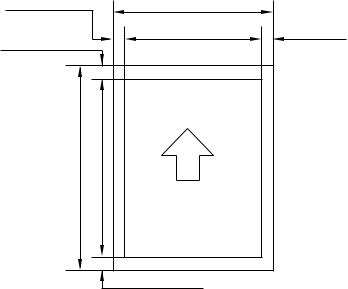
(13) Effective printing area
E |
A |
|
E |
C |
E |
|
|
|
|
Printable area |
|
B |
D |
|
|
E |
|
Figure 1.1 Printable Area
Effective printable area is referred to as a area within which is guaranteed the printing of all interface signal data on a hard copy without any omission.
The tables below shows the effective printable area for each paper size.
Table 1.1 Plain Paper
SIZE |
A (mm) |
B (mm) |
C (mm) |
D (mm) |
E (mm) |
|
|
|
|
|
|
A 4 |
210.0 |
297.0 |
203.2 |
288.5 |
3.39 ± 1.0 |
|
|
|
|
|
|
Letter |
215.9 |
279.4 |
207.4 |
270.9 |
4.23 ± 1.0 |
|
|
|
|
|
|
Legal |
215.9 |
355.6 |
207.4 |
347.1 |
4.23 ± 1.0 |
|
|
|
|
|
|
B 5 (ISO) |
176.0 |
250.0 |
167.5 |
241.5 |
4.23 ± 1.0 |
|
|
|
|
|
|
Executive |
184.2 |
266.7 |
175.7 |
258.2 |
4.23 ± 1.0 |
|
|
|
|
|
|
A 5 |
148.0 |
210.0 |
139.5 |
201.5 |
4.23 ± 1.0 |
|
|
|
|
|
|
B 6 (ISO) |
125.0 |
176.0 |
116.5 |
167.5 |
4.23 ± 1.0 |
|
|
|
|
|
|
A 6 |
105.0 |
148.0 |
96.5 |
139.5 |
4.23 ± 1.0 |
|
|
|
|
|
|
Table 1.2 Envelope
SIZE |
A (mm) |
B (mm) |
C (mm) |
D (mm) |
E (mm) |
|
|
|
|
|
|
COM-10 |
104.8 |
241.3 |
96.3 |
232.8 |
4.23 ± 1.0 |
|
|
|
|
|
|
MONARCH |
98.4 |
190.5 |
89.9 |
182.0 |
4.23 ± 1.0 |
|
|
|
|
|
|
DL |
110.1 |
221.0 |
101.6 |
212.5 |
4.23 ± 1.0 |
|
|
|
|
|
|
C5 |
162.2 |
228.6 |
154.1 |
220.1 |
4.23 ± 1.0 |
|
|
|
|
|
|
B5 (ISO) |
176.0 |
250.0 |
167.5 |
241.5 |
4.23 ± 1.0 |
|
|
|
|
|
|
(The sizes above are nominal sizes according to ISO.)
An A4 sheet accepts 80 PICA-pitch characters (203.2mm).
I - 3
(14) Standard interfaces |
Automatic interface selection |
|||
|
• |
Centronics, Bi-directional parallel |
||
|
• |
RS-232C serial |
|
|
|
Baud rate |
: |
150, 300,1200, 2400, 4800, 9600 |
|
|
|
|
|
19200, 38400, 57600 bps |
|
Stop bit |
: |
1 bit |
|
|
Start bit |
: |
1 bit or 2 bits |
|
|
Data length |
: |
7 bits or 8 bits |
|
|
Parity |
: |
Odd, Even, or None |
|
|
Protocol |
: |
Xon/Xoff or DTR |
|
(15) Emulation |
Automatic emulation selection |
|||
•HP Laser Jet 4 (PCL Level 5e)
•EPSON FX-850
•IBM Proprinter XL
•BR-Script level 2 (PostScript language emulation interpreter)
•HPGL
(16) CPU |
|
79R3041 (20MHZ) |
|
|
||
(17) Resident fonts |
75 scalable fonts and 12 bitmapped fonts |
|||||
|
|
HP Laser Jet 4, EPSON FX-850, IBM Proprinter XL |
||||
|
|
|||||
|
|
Scalable Fonts: |
|
|
|
|
|
|
Intellifont Compatible Fonts: |
Windows 3.1 Compatible Fonts: |
|||
|
|
• |
Albertville, Extrabold |
• |
Tennessee Roman, Italic, Bold, |
|
|
|
• |
Antique Oakland, Oblique, Bold |
|
Bold Italic |
|
|
|
• |
Brougham, Oblique, Bold, |
• |
Helsinki, Oblique, Bold, Bold Oblique |
|
|
|
|
Bold Oblique |
|
• BR Symbol |
|
|
|
• Cleveland Condensed |
• W Dingbats |
|||
|
|
• |
Connecticut |
|
BR-Script Fonts: |
|
|
|
• |
Guatemala Antique, Italic, Bold, |
|||
|
|
• |
Atlanta Book, Book Oblique, Demi, |
|||
|
|
|
Bold Italic |
|
||
|
|
|
|
|
Demi Oblique |
|
|
|
• |
Letter Gothic, Oblique, Bold |
|
||
|
|
• |
Copenhagen Roman, Italic, Bold, |
|||
|
|
• |
Maryland |
|
||
|
|
|
|
Bold Italic |
||
|
|
• |
Oklahoma, Oblique, Bold, |
|
||
|
|
• |
Portugal Roman, Italic, Bold, Bold Italic |
|||
|
|
|
Bold Oblique |
|
||
|
|
|
|
• |
Calgary Medium Italic |
|
|
|
• |
PC Brussels Light, Light Italic, Demi, |
|||
|
|
Brother Original Fonts: |
||||
|
|
|
Demi Italic |
|
||
|
|
|
|
• |
Bermuda Script |
|
|
|
• |
PC Tennessee Roman, Italic, Bold, |
|||
|
|
• Germany |
||||
|
|
|
Bold Italic |
|
||
|
|
|
|
• San Diego |
||
|
|
• |
Utah, Oblique, Bold, Bold Oblique |
|||
|
|
• US Roman |
||||
|
|
• |
Utah Condensed, Oblique, Bold, |
|||
|
|
|
|
|||
Bold Oblique
Bitmapped Fonts (Portrait and Landscape):
•Letter Gothic 16.66 Medium, Italic, Bold, Bold Italic
•OCR-A
•OCR-B
I - 4

|
BR-Script Level 2 Mode |
|
|
|
|
Scalable Fonts: |
|
|
|
|
• |
Atlanta Book, Book Oblique, Demi, |
• |
Albertville, Extrabold |
|
|
Demi Oblique |
• |
Antique Oakland, Oblique, Bold |
|
• |
Brussels Light, Light Italic, Demi, |
• |
Cleveland Condensed |
|
|
Demi Italic |
• |
Conecticut |
|
• |
Brougham, Oblique, Bold, Bold Oblique |
• |
Guatemala Antique, Italic, Bold, Bold Italic |
|
• |
Helsinki, Oblique, Bold, Bold Oblique |
• |
Letter Gothic, Oblique, Bold |
|
• |
Helsinki Narrow, Oblique, Bold, |
• |
Maryland |
|
|
Bold Oblique |
• |
Oklahoma, Oblique, Bold, Bold Oblique |
|
• |
Copenhagen Roman, Italic, Bold, |
• |
Utah, Oblique, Bold, Bold Oblique |
|
|
Bold Italic |
• |
Utah Condensed, Oblique, Bold, |
|
• |
Portugal Roman, Italic, Bold, Bold Italic |
|
Bold Oblique |
|
• |
Tennessee Roman, Italic, Bold, Bold Italic |
• |
Bermuda Script |
|
• |
Calgary Medium Italic |
• |
Germany |
|
• BR Symbol |
|
|
|
|
|
• San Diego |
||||
|
• BR Dingbats |
|
|
|
|
|
• US Roman |
||||
(18) |
RAM |
2M bytes (expandable to 26M bytes) |
|||||||||
(19) |
Font cartridge/card slots |
Two slots |
|
|
|
|
|
|
|
|
|
|
|
One font cartridge slot and one font card slot |
|||||||||
(20) |
Power souse |
USA and Canada |
|
: AC 110 to 120 V, 60 HZ |
|||||||
|
|
Europe and Australia |
: |
|
AC 220 to 240 V, 50 HZ |
||||||
(21) |
Power consumption |
Printing |
: |
500 WH or less |
|||||||
|
|
Stand-by |
: |
80 WH or less |
|||||||
|
|
Sleep |
: |
20 WH |
|
|
|||||
(22) |
Noise |
Printing |
: |
49 dB A or less |
|||||||
|
|
Stand-by |
: |
40 dB A or less |
|||||||
(23) |
Dimensions (W x H x D) |
371.6 x 326.5 x 393 mm (14.6 x12.9 x 15.5 inches) |
|||||||||
(24) |
Weight |
Approx. 15 kg (32.6 Ibs) |
|
|
|||||||
(25) |
Environmental conditions |
|
|
|
|
|
|
|
|
|
|
|
Operating |
Temperature |
|
10 ~ 32.5°C |
|||||||
|
environment |
Relative humidity |
20 ~ 80%RH |
||||||||
|
|
|
|
|
|
|
(No condensation allowed) |
||||
|
|
Air pressure |
|
|
|
613 ~ 1013 hPa |
|||||
|
|
|
|
|
|
|
(0 ~ 2,500 m above sea level) |
||||
|
Non-operating |
Temperature |
|
0 ~ 35°C |
|
|
|||||
|
environment |
Relative humidity |
10 ~ 80%RH |
||||||||
|
|
|
|
|
|
|
(No condensation allowed) |
||||
|
Storage conditions |
|
|
|
|
|
|
|
|
|
|
|
• Printer |
Temperature |
|
|
|
|
|
|
|||
|
|
Normal (total storage time x 9/10) |
|||||||||
|
|
0 ~ 35°C |
|
|
|
|
|
|
|||
|
|
Severe (total storage time x 1/10) |
|||||||||
|
|
High |
|
|
|
|
Low |
|
|
||
|
|
35°C ~ 60°C -20°C ~ 0°C |
|||||||||
|
|
Temperature change (within 3 minutes) |
|||||||||
|
|
High |
|
|
|
|
Low |
|
|
||
|
|
60°C |
|
|
|
15°C |
-20°C |
|
|
25°C |
|
|
|
|
|
|
|
|
|||||
|
|
|
I - 5 |
|
|
|
|
|
|||
Relative humidity
Normal (total storage time x 9/10) 35 ~ 85%RH
Severe (total storage time x 1/10) High Low
85 ~ 95%RH 10 ~ 35%RH
Air pressure 613 ~ 1013 hPa
Total storage time 0.5 years
• EP-ED cartridge |
Temperature |
|
|
Normal (2.45 years max.) |
|
|
0 ~ 35°C |
|
|
Severe (0.05 years max.) |
|
|
High |
Low |
|
35°C ~ 40°C |
-20°C ~ 0°C |
Temperature change (within 3 minutes) High Low
40°C 15°C -20°C
15°C -20°C 25°C
25°C
Relative humidity
Normal (2.45 years max.) 35 ~ 85%RH
Severe (0.05 years max.) High Low
85 ~ 95%RH 10 ~ 35%RH
Air pressure 613 ~ 1013 hPa
Maximum total storage time: 2.5 years including used time
3.SAFETY INFORMATION
3.1 Laser Safety (110 ~ 120V Model only)
This printer is certified as a Class 1 laser product under the US Department of Health and Human Services (DHHS) Radiation Performance Standard according to the Radiation Control for Health and Safety Act of 1968. This means that the printer does not produce hazardous laser radiation,
Since radiation emitted inside the printer is completely confined within the protective housings and external covers, the laser beam cannot escape from the machine during any phase of user operation.
I - 6
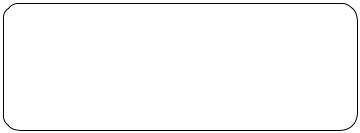
3.2 CDRH Regulations (110 ~ 120V Model only)
The center for Devices and Radiological Health (CDRH) of the US Food and Drug Administration implemented regulations for laser products on August 2, 1976. These regulations apply to laser products manufactured from August 1, 1976. Compliance is mandatory for products marketed in the United States. The label shown below indicates compliance with the CDRH regulations and must be attached to laser products marketed in the United States.
MANUFACTURED :
BROTHER INDUSTRIES, LTD.
15-1, Naeshiro-cho, Mizuho-ku Nagoya 467, Japan. This product complies with FDA radiation performance standards , 21 CFR chapter 1 subchapter J.
Figure 1.2
Caution: Use of controls, adjustments or performance of procedures other than those specified in this manual may result in hazardous radiation exposure.
3.3 Additional Information
When servicing or adjusting the optical system of the printer, be careful not to place screwdrivers or other reflective objects in the path of the laser beam. Be sure to take off any personal accessories such as watches and rings before working on the printer. A reflected beam, though invisible, can permanently damage the eyes.
Since the beam is invisible, the following label is attached to the inside of covers where danger of exposure to laser radiation exist.
Figure 1.3
I - 7
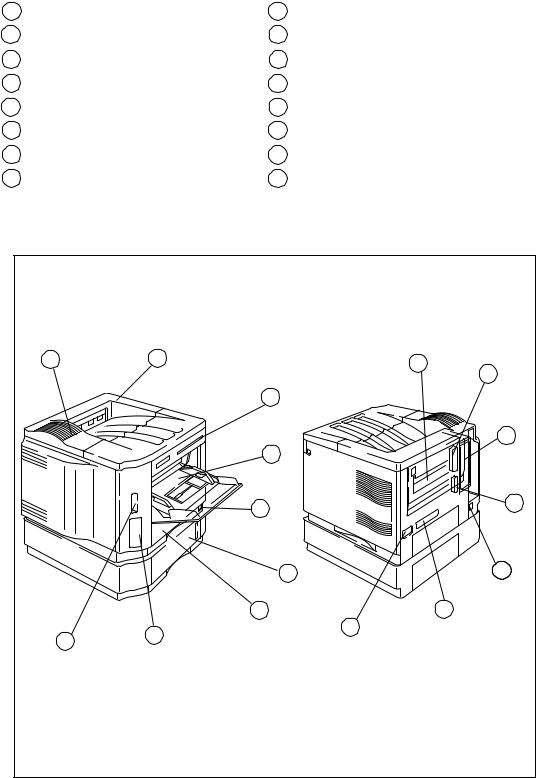
4.PARTS OF THE PRINTER
4.1 External Views
1 |
Upper cover |
9 |
AC inlet |
2 |
Control panel |
10 |
Face-up print delivery port |
3 |
MP tray |
11 |
Fan outlet port |
4 |
Tray 1 |
12 |
Rating label |
5 |
Tray 2 (Option) |
13 |
Optional I/O slot |
6 |
Font card slot |
14 |
RS-232C interface connector |
7 |
Font cartridge slot |
15 |
Centronics interface connector |
8 |
Power switch |
16 |
Optional interface connector |
11 |
|
1 |
10 |
|
|
|
15 |
|
|
2 |
|
|
|
|
13 |
|
|
3 |
|
|
|
8 |
14 |
|
|
|
|
|
|
5 |
16 |
|
|
4 |
12 |
|
6 |
7 |
9 |
|
|
||
|
|
|
Figure 1.4
I - 8
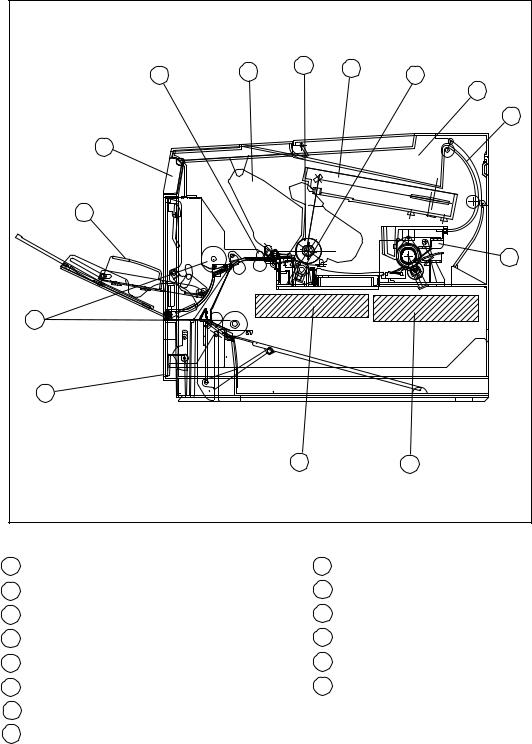
4.2 Cross Sectional View
1 |
2 |
3 |
4 |
5 |
|
|
|||
|
|
|
|
6 |
|
|
|
|
7 |
14 |
|
|
|
|
13 |
|
|
|
|
|
|
|
|
8 |
12 |
|
|
|
|
11 |
|
|
|
|
|
|
10 |
|
9 |
1 |
Registration rollers |
9 |
Low-voltage power supply assy |
2 |
EP-ED cartridge |
10 |
High-voltage power supply assy |
3 |
Photosensitive drum |
11 |
Paper cassette (Tray 1) |
4 |
Laser scanner unit |
12 |
Pick-up rollers |
5 |
Transfer unit |
13 |
MP tray |
6 |
Face-down tray |
14 |
Control panel |
7Print-delivery path
8Fixing unit
Figure 1.5
I - 9
5.STORAGE AND HANDLING OF EP-ED CARTRIDGES
An EP-ED cartridge is influenced by the storage conditions even if it is sealed in its package, so its life depends on the way in which it is used or stored. EP-ED cartridges should be handled carefully.
5.1 Storage of Sealed EP-ED Cartridges
When storing sealed EP-ED cartridges in a warehouse or workshop, the storage conditions shown in (25) Environmental conditions on Page 1-5 must be met. Follow the instructions below:
1)Avoid direct sunlight.
2)Do not store cartridges on a surface that is subject to vibration.
3)Do not hit or drop the packages containing cartridges.
4)The cartridges should be stored horizontal when they are removed from the body (with their label side upside).
5)Avoid putting the cartridges near a CRT screen, a disk or a floppy disk (to keep their data from being destroyed).
5.2Storage of Unsealed EP-ED Cartridges
Each EP-ED cartridge contains a photosensitive drum that has an organic photoconductor (OPC) which deteriorates when exposed to strong light. It also contains toner. The user, therefore, should be fully informed about the correct storage and handling of EP-ED cartridges.
(1)Storage requirements
1)Avoid places exposed to direct sunlight or near a window. Do not leave an EP-ED cartridge in a car in warm or hot weather even if it is in its storage box.
2)Avoid places with a too-high or too-cool temperature and/or humidity. Also avoid places exposed to sudden temperature or humidity changes (such as near an air conditioner outlet).
3)Avoid dusty places or places exposed to ammonia fumes or other harmful fumes.
4)Do not store an EP-ED cartridge in a temperature above 40°C.
(2)EP-ED cartridge life
The effective life of an EP-ED cartridge is 2.5 years from the date of manufacture (printed on the cartridge.) The expiry year and month (date of manufacture plus 2.5 years) is shown on the EP-ED cartridge box. An EP-ED cartridge used after the expiry may produce low-quality printing, so a cartridge should be used within the stated period.
I - 10
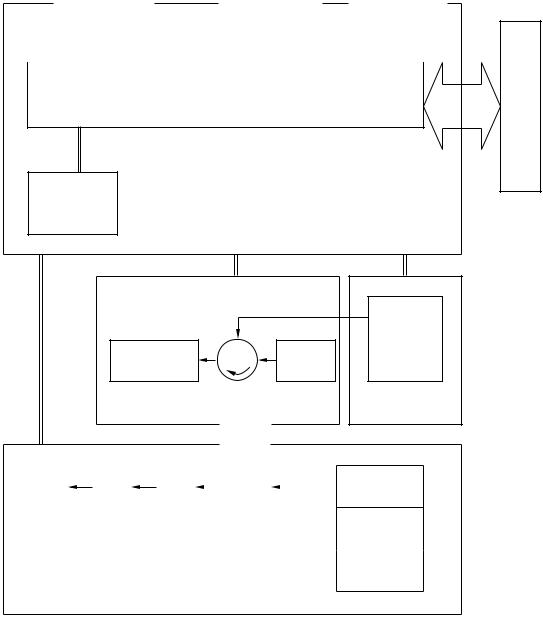
CHAPTER II THEORY OF OPERATION
This chapter describes the printer functions, the relationship between the electrical systems and mechanical systems, and the timing of operations. Striped conduits ( ) indicate mechanical linkages; solid thin arrows (
) indicate mechanical linkages; solid thin arrows (  ) appearing with a signal name indicate the transmission of single control signals and outlined thick arrows (
) appearing with a signal name indicate the transmission of single control signals and outlined thick arrows ( ) indicate the transmission of groups of signals.
) indicate the transmission of groups of signals.
1. BASIC OPERATIONS
1.1 Mechanical Configuration
The printer functions can be divided into four blocks: the laser/scanner system, the image formation system, the paper pick-up/feed system and the control system.
|
|
|
Font cartridge/card |
|
Optional I/O |
|||||
|
Expansion memory |
|
|
(MIO) |
||||||
|
|
|
|
|
|
|||||
|
(SIMM) |
|
|
|
|
|
|
|
|
|
|
|
|
|
|
|
|
|
|
|
|
|
|
|
|
|
|
|
|
|
|
|
Main PCB
Control panel
CONTROL SYSTEM
IMAGE FORMATION SYSTEM
|
Photosensitive drum |
Laser/scanner |
|
|
|
|
|
unit |
Cleaning unit |
Developing |
|
unit |
|
|
|
|
|
|
|
|
|
|
|
|
|
|
LASER/SCANNER |
|
|
|
|
|
|
|
|
|
|
|
SYSTEM |
|
|
|
|
|
|
|
|
Transfer |
|
|||
|
|
|
|
|
|
|
separation |
|
|||
|
|
|
|
|
|
|
unit |
|
|||
rollersDelivery |
|
unitFixing |
|
Feeder |
|
|
|
|
|
MP tray |
|
|
|
|
|
|
|
|
|
|
|
||
|
|
|
|
|
|
|
|
|
|
Tray 1 |
|
|
|
|
|
|
|
|
|
|
|
||
|
|
|
|
|
|
|
|
|
|
|
|
|
|
|
|
|
|
|
|
|
|
Tray 2 |
|
|
|
|
|
|
|
|
|
|
|
||
|
|
|
|
|
|
|
|
|
|
(Option) |
|
PAPER PICK-UP/FEED SYSTEM
Figure 2.1
II - 1
External Device

1.2 Main Drive
The power necessary for driving the printer is supplied by the main motor, the paper feed motor and the scanner motor.
The main motor is controlled by the main motor drive signal (MDRIVE) output from the main PCB, and the paper feed motor is controlled by the paper feed motor drive signal output from the main PCB, and the scanner motor is controlled by the scanner motor drive signal (SDRIVE) output from the main PCB.
Main motor
Main motor drive signal (MDRIVE)
Main PCB
Drum gear
Photosensitive drum
Fixing unit |
Paper delivery |
|
rollers |
||
|
Paper feed motor
Paper feed motor drive signal
MP tray pick-up roller solenoid drive signal (MPSOL)
|
|
|
|
|
|
|
|
|
|
|
|
|
MP tray pick-up |
|
|
|
MP tray |
|
|
|
|
|
|
|
||
|
|
|
|
roller solenoid |
|
|
|
pick-up roller |
|
|
|
|
|
|
|
||
|
|
|
|
|
|
|
|
|
|
|
|
|
|
|
|
|
|
Tray1 pick-up roller solenoid drive signal (PUCL1)
Tray1 pick-up roller solenoid
Tray1 pick-up roller
Scanner motor drive signal (SDRIVE)
|
|
|
|
Note: There are cases, in the following pages, that |
|
|
|
Scanning mirror |
a main motor is referred to as a DC motor, but |
|
|
|||
|
|
|||
|
|
|
|
they are identical. |
Scanner motor
Scanner unit
Figure 2.2
II - 2
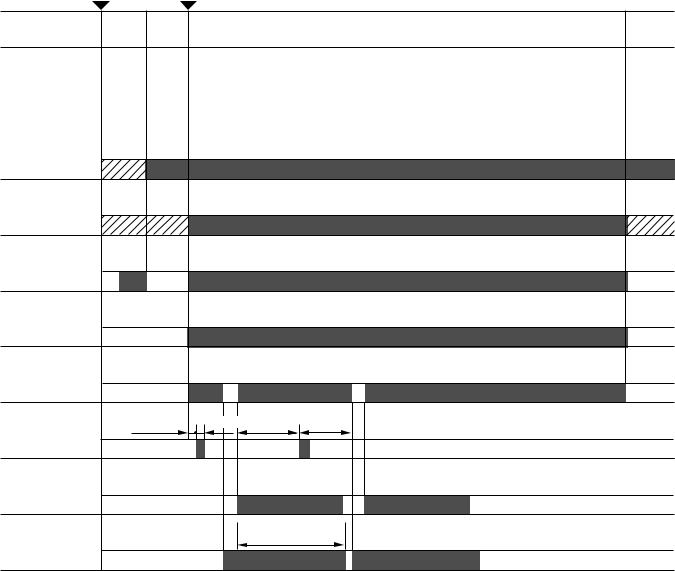
1.3 Basic Sequence of Operations
Timing for two consecutive prints on A4 paper.
|
Power on |
|
|
|
|
|
|
WAIT |
STBY |
|
|
STBY |
|
Ready lamp |
|
|
|
|
|
|
|
|
|
|
|
|
170°C |
Fixing heater |
170°C |
control |
|
|
190°C control |
control |
|
|
|
|
|
|
|
Main motor |
|
|
|
|
|
|
Scanner motor |
|
|
|
|
|
|
Paper feed |
|
|
|
|
|
|
motor |
|
|
|
|
|
|
Pick-up roller |
0.2 sec |
0.2 sec |
2.5 sec |
2.3 sec |
|
|
solenoid |
|
|
|
|
|
|
Laser diode |
|
|
|
|
|
|
Registration |
|
|
|
4.24 sec |
|
|
sensor |
|
|
|
|
|
|
Figure 2.3
II - 3

2. LASER/SCANNER SYSTEM
To external device
Main PCB
SBD DATA VOFF
Scanner driver |
|
Collimator lens |
Scanning mirror |
Cylindrical lens |
|
Optical sensor |
Scanner motor |
|
|
|
Focusing lenses |
|
Beam detect mirror |
Figure 2.4
In response to the print signal transmitted from the external device, the main PCB generates the drive signals (DATA,VOFF) for the laser diode and sends the signals to the scanner unit.
The laser diode in the scanner unit generates a laser beam modulated by DATA.
The modulated laser beam is aligned into a parallel beam by a collimator lens and a cylindrical lens and then brought to the scanning mirror which is rotating at a constant speed.
The laser beam reflected by the scanning mirror focuses on the photosensitive drum via the focusing lenses arranged in front of the scanning mirror.
The path of the beam coming through the focusing lenses is reflected by the reflective mirror.
As the scanning mirror rotates at a constant speed, the laser beam scans the photosensitive drum at a constant speed.
As the photosensitive drum rotates at a constant speed and the laser beam scans the drum, an images is formed on the drum.
II - 4
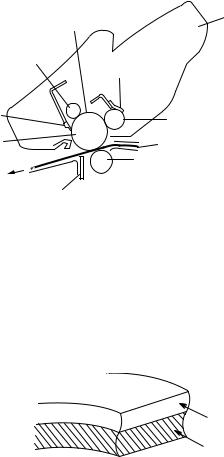
3. IMAGE FORMATION SYSTEM
3.1 Outline
The image formation system is the main part of the printer. The print information, after input from the video controller circuit into the engine controller circuit as a TVDO signal, forms a toner image on the photosensitive drum.
Then the toner image is transferred onto the paper by the transfer charging roller. The image formation system is composed of the photosensitive drum the charging unit, the developing unit and the cleaning unit.
3.2 Printing Process
The major part of the image formation system is contained in the cartridge, as shown in Figure 2.5.
Laser beam |
Cartridge |
Primary charging roller |
Blade |
|
|
Cleaning blade |
Developing cylinder |
|
|
Photosensitive drum |
Paper |
|
Transfer charging roller |
Static charge eliminator
Figure 2.5
The cartridge used by the printer has a seamless photosensitive drum with the structure shown in Figure 2.6. The outer layer of the drum consists of an organic photoconductor (OPC); the base is aluminum.
The printing process can be divided into five major stages:
Photoconductive layer
Base
Figure 2.6
1.Electrostatic latent image formation stage Step 1 Primary charge (-)
Step 2 Scanning exposure
2.Developing stage Step 3 Development
II - 5
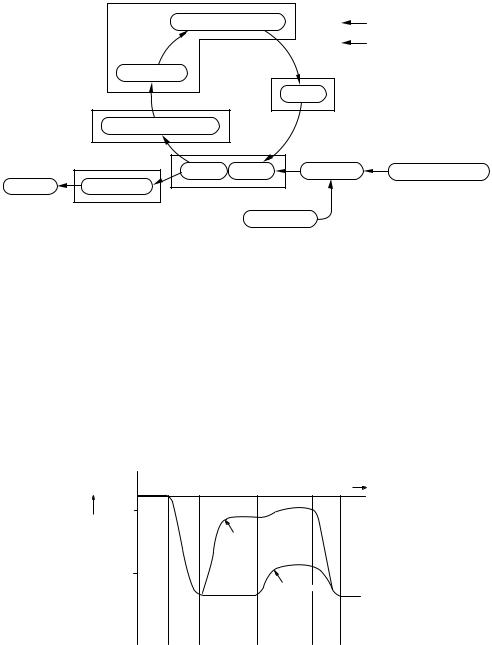
3.Transfer stage Step 4 Transfer (+) Step 5 Separation
4.Fixing stage Step 6 Fixing
5.Drum cleaning stage Step 7 Drum cleaning
|
Electrostatic latent image |
|
formation stage |
|
2. Scanning exposure |
|
1. Primary charge |
|
3. Develop |
|
ment |
Drum cleaning stage |
7. Drum cleaning |
Paper path
Direction of drum rotation
Developing stage
Fixing stage |
|
|
|
|
5. Separa- |
4. Transfer |
Registration |
Multi-purpose tray feed |
|
tion |
||||
|
|
|
Print delivery |
6. Fixing |
Transfer stage
Cassette feed
Figure 2.7
3.2.1Electrostatic latent image formation stage
This stage has two steps, which together produce a pattern of electrical charges on the photosensitive drum.
At the end of the stage, negative charges remain in the unexposed ”dark” area. Charges are absent from the ”light” areas, where the laser beam struck (exposed) the drum surface.
Since this image of negative charges on the drum is invisible to the eye, it is called an ”electrostatic latent image”.
Surface potential (V)
0 |
|
|
Time (t) |
|
|
|
|
-100 |
|
|
|
|
Exposed |
|
|
|
area |
|
|
-500 |
|
|
|
|
|
Unexposed |
|
|
|
area |
|
Primary |
Scanning |
Transfer |
Primary |
charge |
exposure |
(step 4) |
charge |
(step 1) |
(step 2) |
|
(step 1) |
Figure 2.8
II - 6
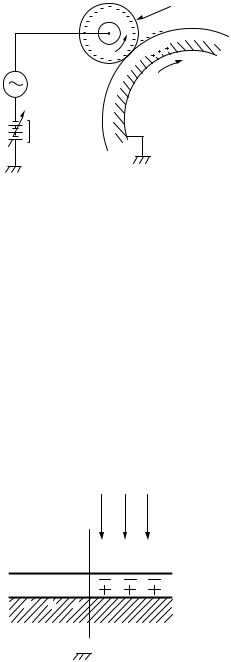
Step 1 Primary charge
Primary charging roller
AC bias
Photosensitive drum
DC bias
Figure 2.9
As preparation for latent image formation, a uniform negative potential is applied to the photosensitive drum surface. The printer uses the charging method that directly charges the drum for the primary charge.
The primary charging roller consists of conductive rubber. In addition to DC bias, AC bias is applied to the primary charging roller to keep the potential on the drum surface uniform. This DC bias is changed with the developing DC bias.
This charging method has advantages such as lower applied voltage, less ozone generation, etc., compared with the corona charge system.
Step 2 Scanning exposure
Laser beam
_ _ _
++ +
|
|
|
|
Unexposed area |
Exposed area |
||
|
|
|
|
Figure 2.10
When the laser beam scans the drum surface, it causes the charge to be neutralized in the areas struck by the beam. Areas on the drum with no charge form the electrostatic latent image.
II - 7
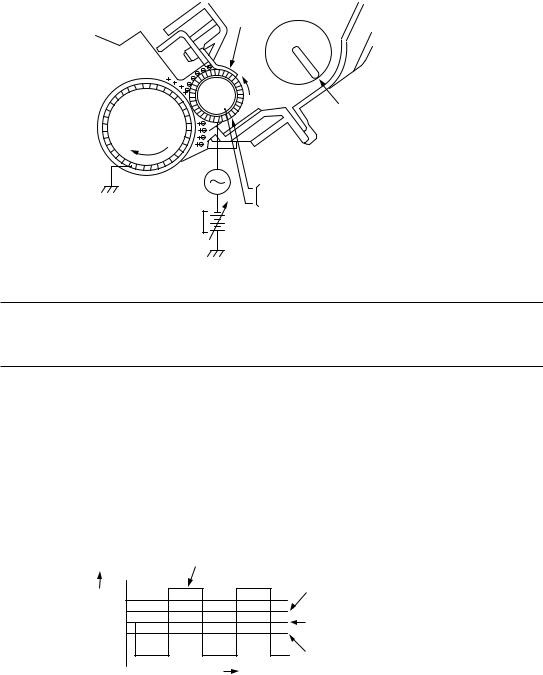
3.2.2Developing stage
Development places particles of toner onto the areas of the drum that have been cleared of charge by the laser beam. This makes a visible image. This printer uses the toner projection development method with a single-component toner.
Step 3 Development
Blade
Photo- |
Stirrer |
|
|
sensitive |
|
drum |
|
AC bias |
Developing cylinder |
Cylinder |
|
|
Magnet |
DC bias
Figure 2.11
Note: The charges on the light areas on the photosensitive drum are shown as positive in this figure. Actually they are negative, but they are more positive than the developing cylinder and explanation is simplified by regarding them as positive.
As shown in Figure 2.11, the developing unit consists of a developing cylinder and rubber blade. The developing cylinder rotates around a fixed internal magnet. The single-component toner consists of magnetite and a resin binder, and is held to the cylinder by magnetic attraction. The toner is an insulator, and acquires a negative charge by friction due to the rotation of the cylinder.
The areas on the drum that were exposed to the laser beam have a higher potential (are less negative) than the negatively charged toner particles on the developing cylinder. When these areas approach the cylinder, the potential difference projects the toner particles onto them. This is called toner projection, and the latent image on the drum becomes visible.
Developing cylinder surface potential
|
+V |
|
Drum surface |
|
|
potential |
|
|
0 |
|
|
(V) |
|
(exposed area) |
|
|
|
DC bias |
|
Voltage |
|
|
|
-V |
|
Drum surface |
|
|
|
Time t |
potential |
|
|
(unexposed area) |
|
|
|
|
Figure 2.12
An AC bias is applied to the developing cylinder to help project the toner particles to the drum surface and improve the contrast of the printed image. The center voltage of the AC bias (1600 Vp-p) varies with the DC bias voltage.
The IMAGE DENSITY ADJUSTMENT signal (sent from the Engine CPU to the high-voltage power supply) changes the DC bias, and thus the potential difference between the cylinder and drum. This changes the density of the print.
This printer has a stirring mechanism to supply toner in the cartridge smoothly to the cylinder.
II - 8

3.2.3Transfer stage
In the transfer stage, the toner image is transferred from the drum surface to the paper.
Step 4 Transfer
Photo- |
|
sensitive |
Paper |
drum |
Transfer charging roller
Figure 2.13
A positive charge applied to the back of the paper attracts the negatively charged toner particles to the paper. The printer accomplishes transfer by using the charging roller method. Advantages compared with the corona transfer method are as follows:
•Low transfer voltage that is less than half that for corona transfer.
•Less ozone generation.
•The paper is supported by the transfer charging roller and photosensitive drum, so feed is more stable.
Reference:
If the image on the photosensitive drum is not completely transferred to the paper due to jamming, etc., the toner may adhere to the transfer charging roller. The printer removes the toner from the transfer charging roller by switching the transfer voltage between positive and negative in sequence. During wait, initial rotation, and last rotation, the printer sets the primary DC voltage to zero, and sets the charge on the drum to zero. In this case, the transfer voltage is made negative to remove the negatively-charged toner on the transfer charging roller to the drum. The transfer charging roller is thus cleaned.
Step 5 Separation
Photosensitive
drum 
 Paper
Paper
Static charge eliminator
Transfer charging roller
Figure 2.14
The stiffness of the paper causes it to separate from the drum. (Curvature separation)
To stabilize the paper feed and prevent small white circles from appearing in the printed image at low temperature and humidity, the charge on the back of the paper is reduced by the static charge eliminator after transfer.
II - 9
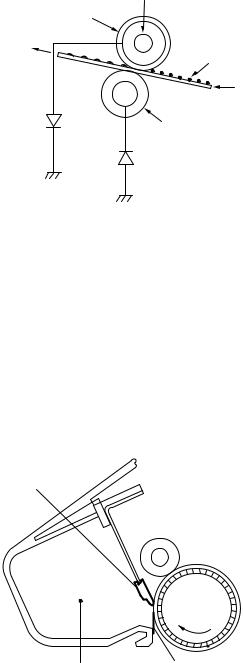
3.2.4Fixing stage
The toner image transferred to the paper in the transfer stage is held only by electrostatic attraction and slight physical adhesion, so even a light touch will smear the image.
In the fixing stage, the toner image is fixed by heating the paper and applying pressure. This fuses the toner particles to the paper to make a permanent image.
Step 6 Fixing
Halogen heater
Upper fixing roller
Toner
Paper
Lower fixing roller
Figure 2.15
The upper roller surface is PFA-coated. The upper and lower roller surfaces are grounded via a diode to prevent the negative potential of the upper roller becoming higher than that of the lower roller, resulting in the toner being drawn to the lower roller, and adhering to the lower roller surface.
3.2.5Drum cleaning stage
In the transfer stage, not all the toner is transferred to the paper. Some remains on the photosensitive drum. This residual toner is cleaned off in the drum cleaning stage so that the next print image will be clear.
Step 7 Drum cleaning
Cleaning blade
Photosensitive drum
Cleaner container |
Sweeper strip |
Figure 2.16
Prior to the next printing, the residual toner on the drum surface is scraped away by the cleaning blade to clean the drum surface. The removed toner is collected in the cleaner container.
II - 10
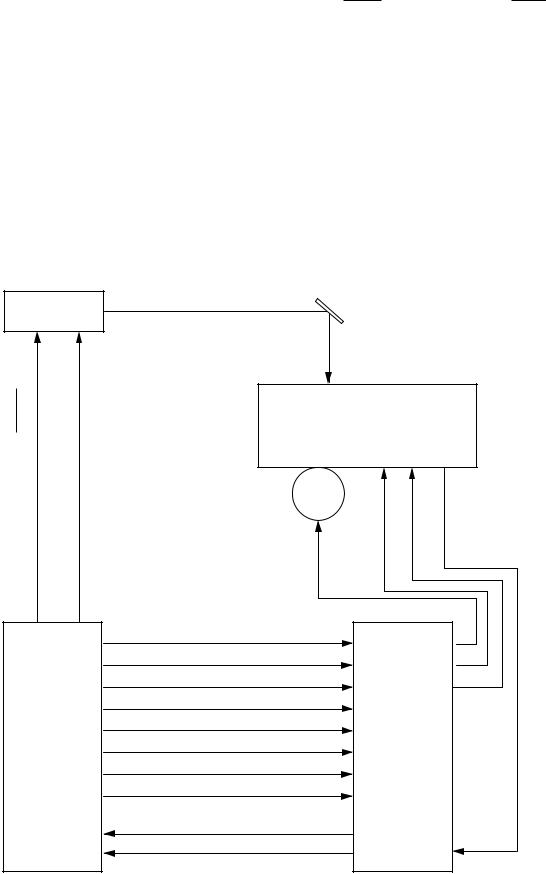
3.3 Operation
When the engine controller circuit receives a print signal (PRINT) or a pre-feed signal (PRFD) from the video controller circuit, the engine controller circuit drives the main motor to rotate the photosensitive drum.
After the drum surface is charged negatively by the primary charge roller, the laser beam modulated by a DATA signal scans the drum surface to from a latent image on the drum.
The latent image formed on the drum surface is converted into a visible image by the toner on the developing cylinder and then image is transferred onto the paper by the transfer roller unit. Then the residual toner is removed from the drum surface with the cleaner blade.
The cartridge also has a toner sensor. When the output from this sensor falls below a certain level, it warns that the EP-ED cartridge will be out of toner with an alarm.
Scanner unit
Scanner motor drive signal (SDRIVE) |
Laser diode drive signal (DATA) |
Reflection mirror
Laser beam
EP-ED cartridge
Transfer roller
Main
PCB
Primary charge (AC) drive (HV1AC) Primary charge (DC) drive (HV1DC) Developing bias (AC) drive (DBAC) Developing bias (DC) drive (DBDC)
Transfer charger 1 drive (HVT1) Transfer charger 2 drive (HVT2) Transfer charger 3 drive (HVT3) Transfer charger 4 drive (HVT4)
Toner sensor signal 1 (TONER 1) Toner sensor signal 2 (TONER 2)
High-voltage power supply PCB
Figure 2.17
II - 11
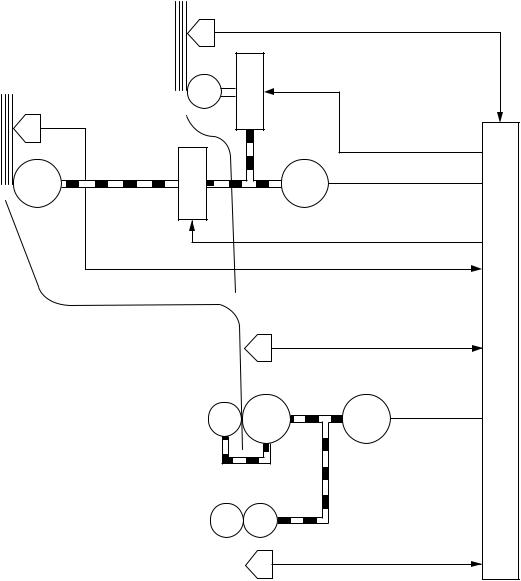
4. PAPER PICK-UP/FEED SYSTEM
4.1 Outline
If a tray1 paper pick-up roller solenoid drive signal (PUCL1) is input to the circuit while the paper feed motor is rotating, the paper pick-up solenoid comes on and the paper pick-up roller solenoid is engaged. As a result, the paper pick-up roller rotates to feed paper down to the photosensitive drum.
The paper position is controlled by the registration sensor so that the leading edge of the paper is aligned with the leading edge of the image on the photosensitive drum. After this operation, the paper is deliveried to the face down tray via the fixing unit. Paper ejection is detected by the paper ejection sensor; if printed paper has not reached or not cleared the paper ejection sensor in a specified time, the printer judges that a paper jam has occurred. In this case a paper jam is noticed to the external devise by a status signal.
MP tray |
paper empty sensor |
Tray paper empty sensor |
Tray1 Pick-up roller solenoid |
Fixing rollers Transfer roller
MP tray paper empty sensor signal (PEMP)
MP tray Pick-up roller solenoid
MP tray pick-up roller solenoid drive signal (MPSOL)
Paper feed motor drive signal
Paperfeed motor
Tray1 pick-up roller solenoid drive signal (PUCL1)
Tray1 paper empty sensor signal (PETRAY1)
|
Registration sensor |
Registration sensor signal (REGIST) |
PCB |
|
Main motor drive |
Main |
|
|
|
signal (MDRIVE) |
|
sensorejectionPaper |
Photosensitive drum |
Main motor |
|
Paper ejection sensor signal (EJECT) |
|
||
|
|
||
Figure 2.18
II - 12

4.2 Cassette Feed
When the fixing rollers reach the specified temperature while a cassette with paper is in the printer, the READY lamp changes from flashing to lighting.
When the engine controller circuit receives PRNT or PRFD signal from the video controller circuit, the paper feed motor starts rotation. About 0.2 seconds later, the printer actuates the tray1 pick-up roller solenoid and the pick-up roller makes one rotation. This feeds paper to the photosensitive drum.
Timing chart for the pick-up one sheet
PRNT or PRFD
|
STBY |
|
STBY |
|
Main motor |
|
|
|
|
Paper empty |
|
|
|
|
sensor |
|
|
|
|
Paper feed |
|
|
|
|
motor |
|
|
|
|
Registration |
|
2.3 sec |
4.24 sec |
|
sensor |
|
|
|
|
Paper ejection |
|
|
2.90 sec |
|
sensor |
|
|
|
|
Pick-up roller |
0.2 sec |
0.2 sec |
|
|
solenoid |
|
|
|
|
Figure 2.19
II - 13

4.3 MP Tray Feed
The timing of the MP tray feed is identical to the timing of the cassette paper feed except for the following points:
(1)The paper empty sensors are different. Cassette feed : Tray1 paper empty sensor
MP tray feed : MP tray paper empty sensor
(2)The pick-up roller solenoids are different. Cassette feed : Tray1 pick-up roller solenoid
MP tray feed : MP tray pick-up roller solenoid
PRNT or PRFD
|
STBY |
STBY |
|
Main motor |
|
|
|
Paper empty |
|
|
|
sensor |
|
|
|
Paper feed |
|
|
|
motor |
|
|
|
Registration |
|
1.12 sec |
|
sensor |
|
|
|
Paper ejection |
|
|
|
sensor |
|
|
|
Pick-up roller |
0.2 sec |
0.2 sec |
|
solenoid |
|
|
|
Figure 2.20
II - 14
